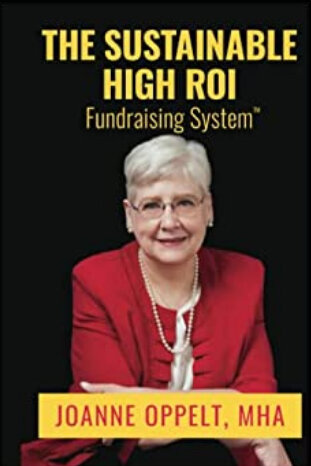The Sustainable High ROI Fundraising System
The concept of fundraising should be a simple and self-explanatory one. It’s right in the name: As a fundraiser, your job is to raise funds. But, as Joanne Oppelt points out in her book, The Sustainable High ROI Fundraising System, there’s more than one way to crack an egg, and not all fundraising methods will yield the same return. Fundraising isn’t a one-size-fits-all process; different methods will work better for organizations of different sizes, longevity, and mission focuses. What Oppelt seeks to do, both in this book and in her career as a development consultant, is to create a system that accounts for all these potential differences and enable nonprofit executives fundraise at maximum efficiency.
What makes Oppelt qualified to create such a system? To start, she’s been working in the nonprofit sector for more than three decades. In her current work as a consultant, she “help[s] deeply mission-focused nonprofits build sustainable revenue systems.” She works toward a world where philanthropic organizations of all shapes, sizes, and backgrounds have the tools and infrastructure they need to survive and thrive, no matter what financial stressors are thrown at them.
This book represents the culmination of all those years of experience. In an effort to make her strategy accessible to all, Oppelt outlines the steps she takes when working with nonprofits—in under 200 pages.
There is no question that her method is presented simply—perhaps too simply, actually, but more on that later. The target audience for the book is nonprofit executives, whom Oppelt directly addresses as she guides the reader through the system. It entails four steps:
1) Assess your nonprofit’s strengths and gaps.
2) Motivate and empower your board to fundraise.
3) Set your development staff up for fundraising success.
4) Build community awareness and support.
The first step requires two chapters to cover. In the first of these, Oppelt explains the “how” of evaluating an organization’s fundraising strengths and weaknesses. “To formulate successful fundraising plans,” she writes, “you need to research and truly understand all the ways your nonprofit is unique.” She lays out which people should be responsible for which parts of this research and how to adapt if you don’t have anyone you can name in those roles. She also covers the best way to analyze the data that comes from that research. The second chapter for this step is about the “what” of these organizational evaluations. Oppelt recommends focusing on assessing what types of fundraising your nonprofit is already engaging in and the technology you’re using to do it.
For the second step, she describes the potential power of a board enthused about fundraising. Board members should be leaders both in strategy and in donating but getting them to think from a development perspective can be easier said than done. Empowering your board to be fundraisers means that they will become even stronger ambassadors for your nonprofit’s mission, their passion for which led them to join the board in the first place.
The third step asks the reader to turn their attention inward and focus on creating an enthusiastic fundraising environment at their nonprofits that sets their staff—particularly, their development staff—up for success. As an executive, Oppelt argues, it is your responsibility to create and distribute the tools and resources that your staff need to thrive.
A key part of this step is to make sure that the makeup of your staff is already contributing to your organization’s success. Oppelt dedicates a chapter to discussing the ideal order of hiring development staff: a development director first, then a fundraising assistant, then a grant writer. And if there’s still room in the budget after that, she recommends hiring “fundraising generalists” who can provide frontline fundraising, development operations, and event support/engagement opportunities for the portfolios they manage. She also details how you can incentivize your fundraising staff to achieve higher returns while remaining ethical.
The final step of Oppelt’s method is getting your community excited. Throughout the book, Oppelt hammers home the idea of being mission-focused: Development isn’t about raising money; to her, it’s about empowering your supporters—whether they be board members, donors, volunteers, or staff—to advance your nonprofit’s mission. In these chapters we see why this is such a focus for her. The community you serve in your organization can become your greatest cheerleader—and that can generate tangible financial results. As she notes, an engaged community can help spread awareness of your nonprofit, rally public support for its mission, advocate for your cause, and draw donors to your work.
There are a few issues with the book, most of which have more to do with its structure and layout than the content. To start, its audience is very narrow; Oppelt makes it abundantly clear that she is only addressing nonprofit executives, which wouldn’t necessarily be a problem, but for a book that is trying to make its thesis accessible to anyone, seems somewhat self-defeating. Although this book is supposed to translate Oppelt’s work as a consultant into a written guide, without her there to personally guide you, many of her comments lack the context needed to be meaningfully helpful. And the sidebars often simply repeat the information, word for word, of the paragraph they’re placed next to.
Perhaps the biggest issue for this reader is Oppelt’s use of real-life examples. These organizations, with which Oppelt worked directly through her consultancy, are useful when it comes to demonstrating the concepts she covers. However, the way they are laid out (rather than highlight a single organization in each chapter to demonstrate how each concept was best utilized, Oppelt includes tidbits from the same four organizations in each chapter) makes it difficult to follow. It’s a challenge to remember, chapter to chapter, which organization did what in the previous chapters.
If the goal of The Sustainable High ROI Fundraising System was to replicate Oppelt’s services as a consultant, the advice offered within is simply too vague and out of context to succeed at that level. But what she has created is a pretty great resource for nonprofit executives hoping to rethink and reinvigorate their fundraising strategies, and that alone has significant value.
Audrey Silverman is a fundraising professional working in the Jewish nonprofit sector.







